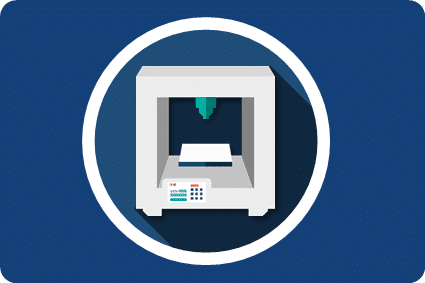Leasing Allows Businesses to Invest in Expensive Assets
Updated 18th May 2021 | 4 min read Published 27th August 2015

3D Printers; as one of the biggest talking points in technology with the potential to transform the manufacturing industry, last year they were arguably one of the most desirable investments. Although the initial excitement has died down, more research is actively going into how we can utilise this innovation in a more mainstream format, but as it currently stands, the costs of owning an industrial 3D printer are too high for many to even consider.
Recently, 3D print specialists, Becoming 3D announced vendor partnerships with two leading US leasing corporations as a way to make high end 3D print hardware and supplies a more realistic and affordable purchase for businesses and consumers. This is just one on many examples where leasing is allowing organisations to invest in big ticket, top of the range machinery that they would not be able to afford through a direct purchase.
The Need for New Equipment
In modern business, in order to stay competitive and make profit, organisations need to invest in new innovations and upgrades. However, as with 3D printers, this comes at a high price and can be a huge risk. For these reasons, purchasing big ticket assets outright is not always a viable option and even if an organisation takes out a loan, they are still committing to the ownership of an expensive asset that is not guaranteed to help the business’s development. This does not alter the fact that companies in all industries need to invest in new equipment in order to grow and compete.
To combat the high costs associated with effective business development, many businesses choose to lease equipment as an alternative form of asset finance. Leasing IT equipment and other notoriously expensive assets provides a greater relief to the company’s cash flow as leasing spreads the cost of the assets over the life span of the lease. This means companies that lease have access to the equipment they require without the often off-putting high initial costs. Unexpected damages and replacements for pricey material handling equipment can bring business to a halt in the construction industry and outdated technology can cause any company to lose out to competitors. Unfortunately, replacing IT equipment, such as all the desktops across a company with hundreds and thousands of employees is not a cheap investment and can be a logistical nightmare. Leasing provides these companies access to the equipment they need, without breaking the budget.
In some industries, such as medical and dental organisations, access to modern technology is vital. Faulty or outdated equipment in hospitals can mean the difference between life and death, but these come at a cost. Funding can often be limited and expensive assets such as ultrasound machines, operating theatre equipment and even replacement beds have to be compromised. Leasing affords these organisations the ability to procure expensive innovations in modern medicine by reducing the impact on their cashflow and allowing them to pay off the asset, whilst providing treatment for patients.
The Leasing Market is Growing
With businesses only beginning to tentatively re-invest money into their organisations in recent years following the economic downturn, these new innovations in modern engineering, efficiency and technology can often seem unattainable for large corporates, let alone SMEs and start-up enterprises. In fact, a recent study by Close Brothers found that 1 in 10 UK SME’s are unsure they will have access to the finances required for investment in the next 12 months. This may explain why institutional investors predict a growth in the alternative finance market by 23% over the next couple of years, which includes an increase in businesses that choose to lease equipment.
Industry experts have estimated that nearly 70% of traditional manufacturers now lease their equipment and with confidence in the leasing market growing on a global scale, this number is sure to rise.
There are a few aspects that you should consider when choosing to lease or buy equipment, such as the length of time you will need the asset and how much control of ownership you actually need. Generally though, the reliefs provided through deciding to lease machinery and equipment – including asset refresh, less impact on cashflow and a variety of financing options – make leasing a much more viable option for procuring expensive assets.
As the CEO of Becoming 3D, Grant Sadowski, says leasing provides businesses “the ability to lease more sophisticated equipment or obtain multiple machines they otherwise would be unable to afford with a direct purchase”.
Get the Most Out of Your Leases
In order to make the very best out of leasing, businesses need to also make sure they are managing their leases effectively. Successful leases are always the result of initial planning and intelligent negotiation during the new lease arrangement. For more information on how to make the most out of your new leases and gain access to the latest developments in industry assets, be sure to view our ultimate guide to leasing.
This guide covers everything finance and procurement teams need to know about making the most out of their leases; from a stage by stage overview of the leasing process up to how best to prepare for changes to global lease accounting, Innervision’s leasing experts have covered every base to make sure you are confident you’re managing your leases efficiently and cost effectively.


